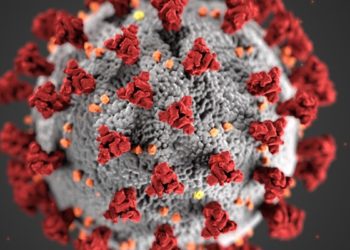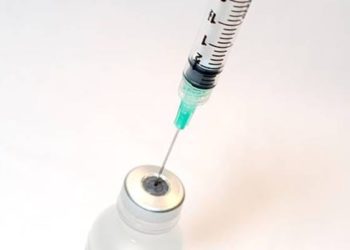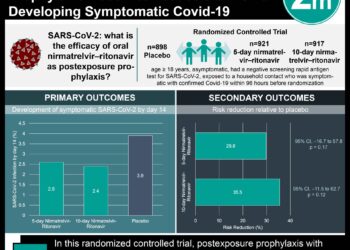Frontline healthcare workers at greater risk of SARS-CoV-2 infection than the general population
1. Healthcare workers in the United States and United Kingdom had at least a three-fold greater risk of COVID-19 infection than the general public.
2. Black, Asian, and minority ethnic healthcare workers were at a disproportionately higher risk of SARS-CoV-2 infection, as were those re-using personal protective equipment or with inadequate supplies, and those in in-patient settings and nursing homes.
Evidence Rating Level: 2 (Good)
Study Rundown: There is limited evidence on the risk of SARS-CoV-2 infection among frontline healthcare providers (HCPs). This prospective, observational cohort study assessed the risk of COVID-19 infection in HCPs compared to the general community, and evaluated demographic and work-related characteristics that carried greater risk of infection acquisition. From March 24 (United Kingdom) and March 29 (United States) to April 23, 2020, more than two million participants voluntarily provided self-reported data using the COVID Symptom Study smartphone application. In addition to demographics such as age, sex, race or ethnic background, height and weight, and occupation and a general medical history, participants were asked to self-report any COVID-19 risk factors, whether or not they have been tested for COVID-19 and the test result if so, on a daily basis. HCPs were asked additional questions regarding personal protective equipment (PPE) availability, contact with COVID-19 patients, and their primary site of clinical practice. In comparison to the general public, frontline HCPs were observed to have a threefold increased risk of reporting a positive COVID-19 test. In particular, Black, Asian, and minority ethnic HCPs were significantly more likely to contract the disease than their colleagues. HCPs working in in-patient and nursing home settings, and those with inadequate or re-used personal protective equipment (PPE) due to limited supplies, were at greatest risk of infection acquisition. This study was limited by self-reported data and a lack of random sampling among selected participants. Since data was primarily collected using a smartphone application, lower penetrance could have occurred among specific socioeconomic groups, such as those over the age of 65 years where smartphone app uptake may have been lower. As well, COVID-19 was diagnosed on the basis of a polymerase chain reaction (PCR) swab rather than antibody testing. Nonetheless, data collection for this study occurred in real-time, minimizing recall bias among participants, and emphasize an increased risk of infection among HCPs which warrants adequate PPE and robust protective workplace strategies with due consideration to high-risk groups.
Click to read the study in The Lancet Public Health
Click to read an accompanying editorial in The Lancet Public Health
Relevant Reading: Coronavirus Disease 2019 (COVID-2019) Infection Among Health Care Workers and Implications for Prevention Measures in a Tertiary Hospital in Wuhan, China
In-Depth [prospective cohort]: This prospective, observational cohort study included 2,810,103 participants who used the COVID Symptom Study app voluntarily from March 24 (United Kingdom) and March 29 (United States) to April 23, 2020.
Among HCPs (n=134,885, 5% of total sample), the prevalence of COVID-19 infection was 2,747 cases per 100,000 people, substantially higher than the general population (242 cases per 100,000 people). After excluding 670,298 individuals from the study due to a lack of follow-up, 2,315,190 participants (of which 99,795 [4.7%] were frontline workers) were included in the final analysis. Compared to the general population, frontline HCPs were more likely to report at least one symptom associated with COVID-19 at baseline (20.2% vs 14.4%).
Over 34,435,272 person-days, 5,545 incident positive COVID-19 infections were reported. In comparison to the general population, HCPs showed a twelve-fold increased risk of incident SARS-CoV-2 infection (adjusted hazard ratio [HR] 11.61, 95% confidence intervals [CI] 10.93 to 12.33); after adjusting for variability in testing frequency with inverse probability weighting for predictors, a higher risk of infection remained evident (HR 3.40, 95% CI 3.37 to 3.43) and predicted COVID-19 from a symptom-free state (HR 2.05, 95% CI 1.99 to 2.10).
The risk of a positive COVID-19 test was substantially high for Black, Asian, and minority ethnic HCPs compared to the general population (HR 21.88, 95% CI 17.78 to 26.94), as was the same for non-Hispanic white HCPs (HR 12.58, 95% CI 11.42 to 13.86); the risk for the former was substantially higher than for the latter (adjusted HR 1.81, 95% CI 1.45 to 2.24). This disparity could be due to the majority of non-white HCPs reporting reuse of or inadequate access to PPE, as both were associated with an increased risk of a positive COVID-19 test (HR 1.46, 95% CI 1.21 to 1.76 for former; HR 1.31, 95% CI 1.10 to 1.56 for latter) compared to HCPs with adequate PPE.
Moreover, the risk of COVID-19 among HCPs caring for suspected and confirmed COVID-19 cases (HR 2.39, 95% CI 1.90 to 3.00 for former; HR 4.83, 95% CI 3.99 to 5.85 for latter) was greater than those not directly providing care to COVID-19 patients. Finally, the risk of disease contraction among HCPs was highest in inpatient settings (HR 24.30, 95% CI 21.83 to 27.06) and nursing homes (HR 16.24, 95% CI 13.39 to 19.70). Of note, Black, Asian, and minority ethnic HCPs were more likely to work in these high-risk clinical settings than their non-white Hispanic counterparts (adjusted OR 1.13, 95% CI 1.03 to 1.23).
Image: PD
©2020 2 Minute Medicine, Inc. All rights reserved. No works may be reproduced without expressed written consent from 2 Minute Medicine, Inc. Inquire about licensing here. No article should be construed as medical advice and is not intended as such by the authors or by 2 Minute Medicine, Inc.







